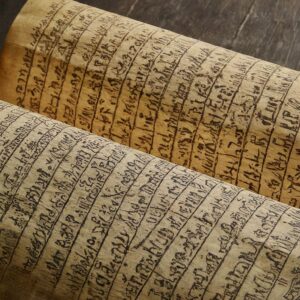Veda in Sanskrit means the science of knowledge. It has other names such as Shruti, Agama, Amnaya etc. The contents are very huge and it was initially divided into four divisions for the convenience of teaching and learning, with the names as Rigveda, Atharvaveda, Samaveda and Yajurveda. In due course of time, each division were further classified as main branches and auxiliaries or Vedashakhas and Upa-Vedas, dealing with different specialized subjects.
Bharadvaja Ashrama was like a University in olden days. Gauthama Ashrama was another such example. The classification of a particular Veda has no particular date and time. Sushruta was the son of Vishwamitra Rishi. He had written books on medicines. One Rishi with the formal name as Bharata had composed verses on Natya shastras. Chanakya had composed books on Arthashastra. Maya had contributed to archeology and artilleries. All are in Sanskrit. These developments were concluded as the basics for job oriented courses.

Gradually, the four branches of Vedas were learnt by the students separately according to their aptitudes, further evolving into ten clear branches. Surgery and medicines were studied by the students of Rigveda having the branch name as Shakhala Shakha and those verses pertaining to their aptitudes were termed as Ayurveda and later, that auxiliary branch continued as Upaveda of Rigveda. Thus medical field got the name evolved as Ayurveda. Rigveda had only one branch, so one wing Ayurveda is the one assumed Upaveda, continuing even now .
Finances, taxation, and evaluation of gold, silver, cost of labor etc. were studied by the students of Atharvaveda and those verses pertaining to their aptitudes were sought from Arthashastra. That auxiliary branch dealing with those disciplines had branch name as Pippaladaya, later continued as Tolana (Vanijya or commerce) considered as Upaveda of Atharvaveda. Interestingly that name evolved as Arthashastra.
Atharva Veda had the second branch with name as Shaunakiya. Measurements of mass or weight, volume, distances, assets and time were studied by the students of Atharvaveda and those verses pertaining to their aptitudes were sought from Arthashastra. That auxiliary branch dealing with those disciplines had branch name as Shaunakiya, later continued as Mapana (Sankhya) considered as Upaveda of Atharvaveda. In the Amarakosha of Amarasimha, the word Arthasastra is available but Atharvaveda is not seen. The reasons are innumerous.
Samaveda has three branches: Jaiminiya, Kauthuma and Ranayanika. Under the Jaiminiya Shakha of Samaveda, the students learned and advanced Yoga shastra, Nyaya and Mimamsa. Regarding the Mimamsa Science, one article is already available in this website and the esteemed readers are requested to browse for more details about it. These are ‘Muni Manasika’ and Nyaya (law) Upavedas of Samaveda.
The audio branch of Samaveda is more emphasized in Kauthuma Shakha. Music is studied by the students of Samaveda Kauthuma shakha and those verses pertaining to their aptitudes were termed as Sangeetashastra and later that auxiliary branch continued as Upaveda of Samaveda. The visual branch of Samaveda is more emphasized in Ranayanika Shakha. Dancing is studied by the students of Samaveda Ranayanika shakha and those verses pertaining to their aptitudes were termed as Natyashastra and later that auxiliary branch continued as Upaveda of Samaveda. Sangeetha (music) intensifies in audio instrumental items such as,flute, drums, Nadaswaram, Tabla etc. Nritya, Natya or Bharatanatya intensifies in visual arts or items. Yakshagana, Bharatanatyam, Odissi, Mohiniyattam, Kuchupudi etc. are learnt based on these Upavedas of Samaveda. For the better performances by the group of expert artists within their field, i.e., audio and visual performers, co-operation is a must.
Coming to the Upavedas of Yajurveda, four branches are found. Basically, Yajurveda had two classifications with name as Shukla and Krishna Yajurvedas. Each classification further had two sub-branches each making the total in four. These four branches are Shukla-Kanva Shakha, Shukla Vajasaneya Shakha, Krishna Taittirya Shakha and Krishna Maitrayaniya Shakhas.
Dhanurveda, Shilpasastra, Krishi Vijnana, textile making, carpentry, excavation of wells, searching for ground water, etc. were studied by the students of Yajurveda and those verses pertaining to their aptitudes were termed as Dhanurveda or Shilpasastra and later that auxiliary branch continued as Upaveda of Yajurveda. Thus the name evolved as Dhanurveda. Sciences that intensify in protective items such as baking (Pakashastra), textile manufacturing (Sericulture), building constructions (Shilpasastra) etc. had been mandatory for the rulers or kings. Such experts were more concerned on these skills and hence the Dhanurveda was more populated by the governing bodies in India. Pure Dhanurveda was an optional subject to the people having aptitude for jobs in the defensive wings aligning with kings. Youngsters studied them for royal families or joining in armies later as job oriented courses.
Sanskrit was considered as a fully developed language. In its alphabet, starting from the oval A and continuing with K (consonants) etc., the more populated written language was Sanskrit. It was a specialized common language for higher education in India (the original name of this Empire being Bharatha Varsha then). For the common civilians there was absolute freedom in life and in their private language usages.
In the learning of Indian music (Sangeetha), the Upaveda of Samaveda, while commencing the learning of music, even today, the initial three starting sound notes recited by the pupils are Saa, Paa and Saa. The reasonable decoding is very clear and comprehensive. The word ‘Sanskrit’ naturally starts with ‘Saa’. The fifth note means Panchama is ‘Paa’. Pakaram Panchamasya. Naturally there were five auxiliary colloquial primitive languages. Panchabhashas, means five Sanatana aligned ancient languages. In the five Sanatana Sanskrit ‘Tadbhava’ languages, people had full freedom in private life but no idea of religion then. Gradually, after British ruling, separate religions also got recognition and they are as follows
- Pracheena = Prak+cheena, Eastern side Chinese or Daoism existed.
- Pratheecha = Pratheech+disha, Western side Parsi’s existed.
- Pali = Budhism, Northern (Tibet) or Southern sides of India (Ceylon) existed.
- Prakrit = Jainism, Inside India or in Indonesian Islands existed.
- Punjabi = Five River banks surroundings area Sikhs existed.
Sanskrit Language or its knowledge is not mandatory now. Upaveda has no authority but has a distinct specialized branch as Ayurveda. The field of Ayurveda has far advanced due to the research and developments. Even though the Upaveda is still considered relevant for the name as Ayurveda, it would continue to exist with side by side of Allopathic systems of medicines as a separate entity. The present working environments in the society are fast changing. Several verses of Rigveda are translated into the European or Western languages. In the Mahabharat story verses, we could get various incidences, are now available in Allopathic medical sciences, for the use of mankind. The purposes of Vedic verses are always to serve the human society. Veda always supports happy human life, without causing sorrows to anybody.
Arthasastra another Upaveda has free existence or has a distinct specialized branch of science now with the name of Modern Economics. The field of Economics has far advanced due to the marketing research and Industrial developments. Even though the basic idea of Upaveda is still there, it would continue with side by side of GDP details of a nation as a separate entity. The present working environments in the society are fast changing but the gold and silver are always used as media price indices for the commercial exchanges. Several verses of Atharvaveda are translated into the European or Western languages. In the Arthasastra of Chanakya we could get various current references. Such incidences are now available in the present Mixed Economy System of India for the peaceful and best use of mankind, either in the micro or macro forms.
All these five languages and religions had evolved from the Ancient Sanatana Dharma and Sanskrit. The ancient Tamil and Sanskrit blended together in South India, hence the Malayalam language evolved. Always the Sanatana Dharma has retained its original form even in Malayalam, showing the influence of Sanatana Dharma in Mohiniyattam dance etc.
Music with dancing is another Upaveda branch but it has always had a free existence. It has a distinct specialized branch of science having the name as Cultural Activities. The field of Indian dancing system has far advanced effects in the society on citizens due to metalinguistic states and developments. Even though the Upaveda is still there, it would continue with side by side of electronic modern instruments as a separate entity. The present working environments of artists in the society are fast changing. Several verses of Samaveda and Kalidasa’s dramas are translated into the European or Western languages. In the Natya Sastra of Bharata, we could get various incidences. Such items are now available in the present video playing of any media samples of India for the peaceful and best use of mankind. Artificial Intelligence is also supporting Upaveda.
After the British Rule of India, the Upaveda got new structure and names. Civil Engineering or Architecture is taught as a professional subject. In the field of medicines also, the higher education and award of postgraduate degrees got new meaning. However the Vedangas and Upavedas were referred only for the ease of learning by the students. The system of job practice also contributed to the field of Upavedas. Indian Upavedas are oriented on sincere services. Vedangas are purely in Sanskrit language, but available in local languages for the usage as complementary.
The benefit of Upaveda is unavoidable in the present day life. It has merged in various languages of this world; the knowledge branch is identified by various other names. Moreover it is optional to learn all these subjects. The tax payment to the Government is a primitive system. The digital form is very easy for a common citizen to follow. The ancient Sanskrit system may be difficult to follow due to lack of knowledge of Sanskrit.
‘गतानुगतिको लोकः ‘. Meaning: We have to follow the well versed in the trade. In this world, the follower follows the right persons. Education is our need for the civilization.
In the field of music or dramatics also. we can observe drastic changes. Kalidasa had written Shakuntala drama, Satya Harischandra is another one. In all Indian languages, we can observe these dramas played, moreover in the entire world these may be available in other dialects. The basic message of Indian Sanskrit drama is famous, to prove that the life is always ending in happiness, even though death is unavoidable.
Coming to the Upaveda of Yajurveda, the picture is more interesting. We can take examples of Ajanta caves and their engraved permanent messages. The peaceful period in the society are lasting for many centuries, told by the granite structures. War periods are very short but the results are causing social system changes. Use of elephants, horses, chariots are seen and engraved in granite stones in these caves. Ground water, wells and agriculture were practiced in the societies. The Upaveda disciplines are vast subjects. Indian knowledge on gems and jewels were very primitive.
There are many ancient Rishis famous for different contributions to the societies. Lomaharshana or Romaharshana Rishi was the fifth disciple of Vedavyasa Rishi. Vyasa had taught him all the eighteen Puranas. Later he had propagated all the Puranas in Naimisharanya. There is no clear cut segregation like Upaveda branches but made only assumptions. The science of Indian music is elaborated in Brahmanda Purana and Romaharshana Rishi is responsible for it like Bharata for Indian dance. Flute is the most famous instrument used by God Krishna. Flute is a proof of an Indian invention.
What is the purpose of this article? How is this beneficiary to the reader?
Human beings have to live in this world with happiness. If anybody suffers or is not satisfied in life, then the negligence of Upaveda items are the reasons for such sorrows. Then Karma Siddhanta, and Mimamsa Science are the remedial path of life, leading towards happiness and satisfaction. So the purpose and benefit serves.
Let us pray to Krishna, the holy God, to shower blessings upon us always.
In future also, readers may expect better articles in this website frequently.

Leave a Reply